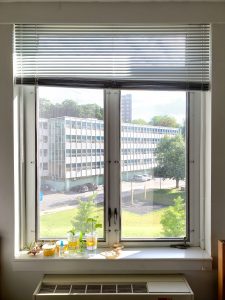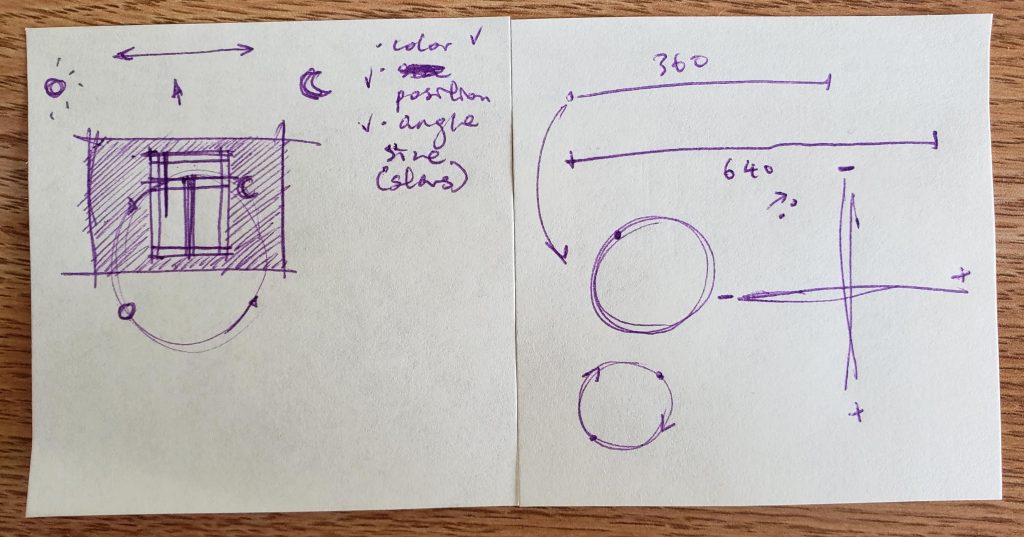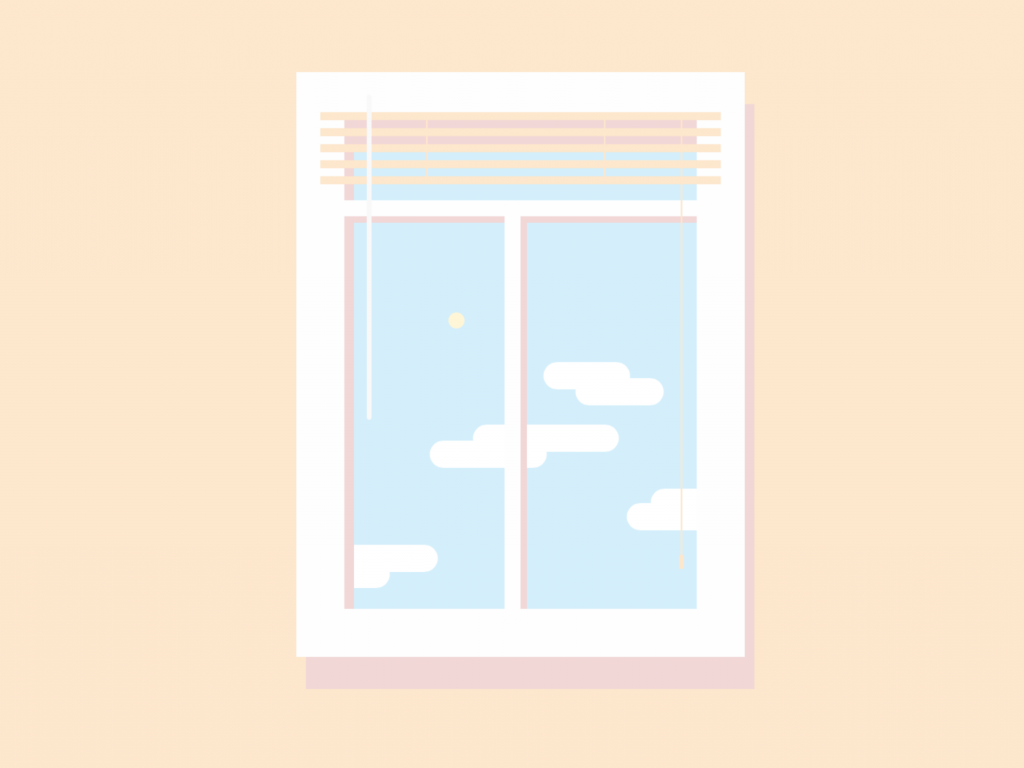/* Hannah Cai
Section C
hycai@andrew.cmu.edu
Project-03-Dynamic Drawing
*/
var R = 211; //sky color variables
var G = 239;
var B = 252;
angleSun = 0; //sun and moon rotation angles
angleMoon = 0;
cloudColor = 250;
cloudX = 0;
var dimness = 0;
function setup() {
createCanvas(600,450);
}
function draw() {
scale(.9375);
rectMode(CORNER);
var cmouseX = constrain(mouseX,0,600); //constrains mouseX to canvas
// sky
background(R,G,B);
// stars
fill(211,239,252);
strokeWeight(1);
stroke(211,239,252);
point(386,153);
point(360,200);
point(266,225);
point(395,355);
// sun
push();
noStroke();
fill(255,247,215);
ellipseMode(CENTER);
translate(675,500);
angleMode(DEGREES);
rotate(angleSun); //rotates the sun
ellipse(-390,-300,10,10); //relative to translated origin
pop();
// moon
push();
noStroke();
fill(250);
ellipseMode(CENTER);
translate(675,500);
angleMode(DEGREES);
rotate(angleMoon); //rotates the moon
ellipse(-390,-300,10,10); //relative to translated origin
fill(R,G,B); //fills with sky color
ellipse(-389,-301,10,10); //second circle that forms the moon
pop();
// clouds
noStroke();
fill(cloudColor);
rect(286 + cloudX,226,54,17,10);
rect(306 + cloudX,236,55,17,10);
rect(242 + cloudX,265,91,17,10);
rect(215 + cloudX,275,73,17,10);
rect(353 + cloudX,305,67,17,10);
rect(338 + cloudX,314,58,17,10);
rect(150 + cloudX,340,70,17,10);
rect(150 + cloudX,350,40,17,10);
//wall
fill(255 - dimness,232 - dimness,204 - dimness);
rect(440,0,200,480);
rect(165,0,310,80);
rect(0,0,200,480);
rect(180,400,310,80);
//window shadow
noFill();
stroke(244 - dimness,216 - dimness,216 - dimness);
strokeWeight(30);
rect(206,80,250,335); //big frame
strokeWeight(10);
line(204,134,444,134); //horizontal part of 'T'
line(324,134,324,389); //vertical part of 'T'
//window frame
stroke(255 - dimness);
strokeWeight(30);
rect(200,60,250,335); //big frame
strokeWeight(10);
line(200,130,440,130); //horizontal part of 'T'
line(320,130,320,385); //vertical part of 'T'
//shades
noStroke();
fill(255 - dimness,232 - dimness,204 - dimness);
rect(200,70,250,5);
rect(200,80,250,5);
rect(200,90,250,5);
rect(200,100,250,5);
rect(200,110,250,5);
stroke(255 - dimness,232 - dimness,204 - dimness)
strokeWeight(1);
line(266,70,266,110); //hanging lines
line(377,70,377,110);
strokeWeight(1);
line(425,70,425,351); //pull line
rectMode(CENTER);
rect(425,350,2,8,2,2,0,0); //pull line handle
stroke(250 - dimness);
strokeWeight(3);
line(230,60,230,260); //rod
//changes based on mouseX's position on the canvas
R = ((527.5 - mouseX) / 2.5);
G = ((597.5 - mouseX) / 2.5);
B = ((630 - mouseX) / 2.5); //lighter/darker sky color
angleSun = ((0 - mouseX) / 10);
angleMoon = ((cmouseX - 600) / 10);
cloudColor = ((775 - cmouseX) / 3); //lighter/darker
cloudX = ((640 - cmouseX) / 12); //horizontal shift
dimness = ((25 + cmouseX) / 25);
}




Like many other people, I struggled with starting this project because it’s so open-ended. I initially wanted to do something abstract, but after a few experiments, I decided to just stick with imagery that I was familiar with. This sketch was based on my dorm’s window. I wanted to show the passage of time by having the sun and moon rotate, as well as having the sky change color. Both of those variables ended up being challenging to manipulate in a way that would look realistic, but still keep them relative to the mouse; I ended up doing a lot more math than I liked, but I figured it out in the end. I realize now that I could’ve used map() rather than doing so much math, similar to the second project, where I did rotations and shears the longer way rather than using push() and pop(), which I hadn’t known about yet. Oh well…
I also wanted to add an interaction where you could click the canvas to turn a light on and off, but after I figured out how to make it work, I didn’t like the effect (it looked weird during the daytime). So I instead just mapped the room to change brightness with the mouse’s movement as well, which also made the passage of time more convincing.
(note: I scaled down my sketch so it wouldn’t get cropped.)
![[OLD FALL 2018] 15-104 • Introduction to Computing for Creative Practice](https://courses.ideate.cmu.edu/15-104/f2018/wp-content/uploads/2020/08/stop-banner.png)